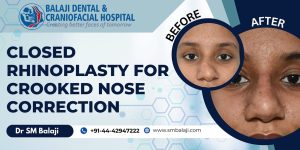The various causes that lead to partial or complete facial paralysis
Facial paralysis means loss of facial movements due to nerve damage. It usually affects only one side of the face. The muscles on that side weaken and appear to droop. Causes of facial paralysis include infection, injury, tumor or stroke.
Patient presents to the hospital for treatment of long standing facial paralysis
This lady from Kurnool has had drooping of the left side of the mouth for a long time now. This caused problems with both eating and speech. There has also been constant drooling of saliva on that side. Her family’s search for the best facial reanimation surgeon led them to our hospital.
The patient examined thoroughly and treatment planning explained
Dr SM Balaji examined the patient. Diagnosis was lower motor neuron facial paralysis of the left face. Treatment planning was then explained to the patient. This would involve static reanimation using fascia lata sling graft. The patient agreed to the treatment plan and was then scheduled for surgery. A fascia lata sling operation is a static procedure done to improve the symmetry of the mouth. It is the most preferred material for sling because it is tough enough to support the mouth. More than one strip can be also taken for creation of different vectors to aid in suspension.
Surgical procedure of static suspension with fascia lata strip for facial reanimation
Under general anesthesia, a fascia lata strip was first harvested from the thigh. The incisions were then closed with sutures. An elliptical incision was then made in the right nasolabial fold. Another small incision was then made on the right zygomatic arch. A tunnel was then created below the skin. The fascia lata strip was then tunneled through to the zygomatic arch. It was then sutured to the atrophic orbicularis oris to act like a sling for the modiolus.
Lateral tarsorrhaphy also performed to establish good facial symmetry
This procedure created symmetry of the lips, corners of the mouth and laugh lines. Lateral tarsorrhaphy was then done to for partial closure of the eyelids. This would ensure that the patient was able to close her eyelids. Good facial symmetry resulted from these procedures.
The patient expressed her happiness at the results before final discharge from the hospital.





